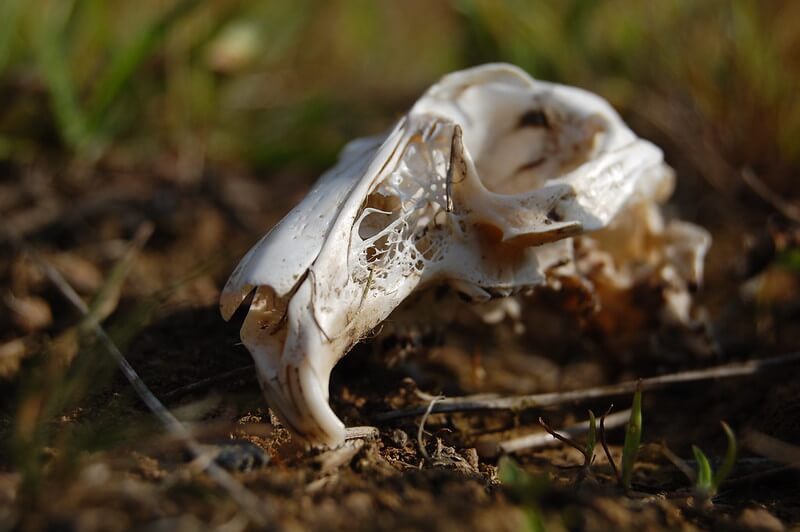Cooperative Decomposition: Recycling in Its Truest Form
By Annie Mealey
Broadcast 3.30.2022

Rabbit skull. Photo by Flickr user Thomas Wood, CC 2.0.
Listen:
I thought I had found the perfect specimen for my study of decomposition so I carefully moved the body off the trail, using twig chopsticks and some bigger sticks to mark the spot. The little vole had been freshly killed and I delighted in observing its adaptations to underground living: velvet fur, powerful digger paws, and sleek body. It’s hard to do such a close-up study when they are scurrying about.
I excitedly returned to the spot the next day only to find the vole was gone. It must have provided lunch for another creature!
I realized that to study decomposition of dead animals I would need to find some carrion. If it was writhing in insects and smelled bad, so much the better. Many little creatures are decomposers and their lives depend on the death of others; such is the cycle of life. Recycling in its truest form!
Driving home, I spotted a flock of vultures circling something on the side of the road. I pulled over and the vultures scattered, enabling me to see what they were feeding on. There were brown, iridescent feathers and bones scattered around. Using my forensic skills I surmised that this was a wild turkey, perhaps killed by a coyote or a passing car.
Vultures perform the crucial role of cleaning up carrion, which helps prevent the spread of disease. They have strong hooked beaks for tearing, a third eyelid that protects their eyes, and gut flora that keeps the decaying meat from being toxic to them. They move in and out quickly, before the meat turns too rotten. Who can blame them?
I returned two days later and saw there was very little left of the turkey. Other scavengers, such as coyotes and crows, may have feasted as well. Now it was time for the decomposers to start their work. Blowflies, flesh flies, and house flies were buzzing around the carcass, seeking a good nursery for their offspring. Thanks to the larger scavengers, various parts of the dead animal were exposed and the insects moved into those spaces, seeming to work together.
If you’ve ever walked by a carcass you may know what happened next: the turkey became bloated, moving into the icky, smelly phase of decomposition. I didn’t want to get very close to the carcass but I was curious. The flies were gone and my favorite invertebrates had arrived: the flesh-eating, or dermestid, beetles, from the Greek word meaning “skin.” They love to feast on the maggots (courtesy of the flies) and make quick work of the rest of the flesh, laying their eggs and cleaning the bones. These beetles work cooperatively and can even band together to move parts of animals, sometimes burying them for later. As I watched the beetles do their work I fondly remembered how, back in college, when we found a road-killed animal, we’d carefully transport it to the lab at school and put it in a cage full of dermestid beetles. We’d have a clean skeleton to study within days.
My brief study didn’t feel macabre to me, once I realized how truly remarkable it is to see how life is cycled through an ecosystem. Nothing is wasted. Every piece gets recycled and renewed. I plan to return to the spot sometime next year to see what plants have sprung up because the soil was enriched by all the decomposers doing their jobs in the cycle of life.
Next time you are out hiking and come across a dead animal, think about the cooperation needed to decompose the body, and how that animal’s death benefits countless other organisms. Nature has so much to teach us.
Every week since 1991, Field Notes has inquired about Montana’s natural history. Field Notes are written by naturalists, students, and listeners about the puzzle-tree bark, eagle talons, woolly aphids, and giant puffballs of Western, Central and Southwestern Montana and aired weekly on Montana Public Radio.
Click here to read and listen to more Field Notes. Field Notes is available as a podcast! Subscribe on iTunes, Google Play, or wherever you listen to podcasts.
Interested in writing a Field Note? Contact Allison De Jong, Field Notes editor, at adejong [at] montananaturalist [dot] org or 406.327.0405.
Want to learn more about our programs as well as fun natural history facts and seasonal phenology? Sign up for our e-newsletter! You can also become a member and get discounts on our programs as well as free reciprocal admission to 300+ science centers in North America!












